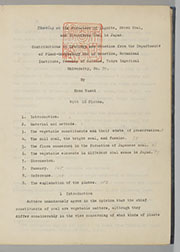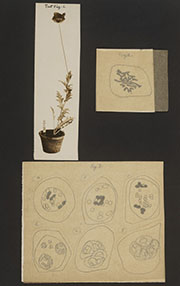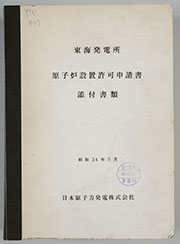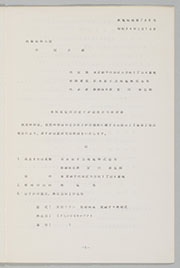70th Anniversary Commemorative Exhibit "A Treasure Box of Books - The 70-year History of the National Diet Library and Its Collections"
- A Treasure Box of Books
- Part 2 Diverse Collections
- Chapter 3 Books depicting society of the day
- Section 2 Japan's science and culture
Part 2 Chapter 3 Section 2 Japan's science and culture
This section consists of exhibits focusing on science and culture in postwar Japan. The doctoral dissertations, nuclear reactor installation (modification) authorization applications, TV show scripts, and other documents exhibited in this section are part of a distinctive National Diet Library collection.
113 Studies on the structure of lignite, brown coal, and bituminous coal in Japan by YASUI Kono, 1927 [UT51-59-N337]
Yasui Kono was a botanist born in 1880. She was the first Japanese woman to be awarded a doctorate (doctor of science), in 1927 from Tokyo Imperial University. The exhibited material is the doctoral dissertation submitted at that time. Yasui blazed the trail for female scientists in Japan, sincerely dedicating herself wholeheartedly to her research, and later served as a professor at Ochanomizu University.
- Collection of doctoral dissertations
-
The National Diet Library holds doctoral dissertations for doctorates bestowed from September 1923 onward. These were first transferred from the Ministry of Education in 1935. Thereafter, they were collected through submission by doctorate granting institutions via submission to the Ministry of Education. In addition, from April 2013 onward, it became the general rule for doctorate granting institutions to publish the full text of doctoral dissertations on the Internet. The National Diet Library began collecting electronic versions from that point.
The collection of doctoral dissertations held by the National Diet Library could be said to be the fruits of nearly 100 years of Japan's academic knowledge.
114 Tokai hatsudensho genshiro secchi kyoka shinseisho, Nihon genshiryoku hatsuden, 1959 [Y95-B49]
Electric power providers who wish to install a nuclear reactor must first submit an installation authorization application to the government. The exhibited material is the application for the Tokai Power Plant (Tokaimura, Ibaraki Prefecture), Japan's first commercial nuclear power plant. The Tokai Power Plant operated from 1966 to 1998 before being decommissioned.
115 Chukanshi no honsei ni tsuite by YUKAWA Hideki
(Kagaku Kikan, first publication, Akitaya, January 1949 [Z405-Ka24])
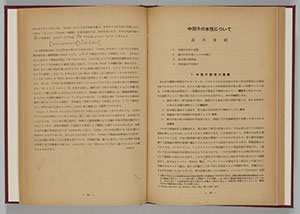
Yukawa Hideki was awarded the Nobel Prize for Physics in December 1949 for his paper released in 1935, which predicted the existence of mesons. This was the first Nobel Prize awarded to a Japanese individual. The displayed section is a thesis summarizing the main points of a lecture to the Physical Society of Japan in 1947.
116 Bunmei kaika ni okeru kyokun to bungaku no sogo hikaku kenkyu by Robert Campbell, The University of Tokyo, Robert Campbell, 2010 [Y151-H15320028]
Grants-in-Aid for Scientific Research are subsidies granted by the government for academic research based on original ideas by researchers. Research results reports which compile research results in booklet format are housed by the Kansai-kan of the National Diet Library. The exhibited materials are those of Robert Campbell, the director of the National Institute of Japanese Literature and well known from TV.
117 Taiyo ni Hoero! Revision 111 by OGAWA Ei, broadcast August 30, 1974 [Y851-N01-16283]
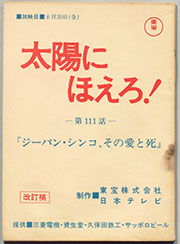
Taiyo ni Hoero! (Bark at the Sun) is a detective drama broadcast on TV from 1972 to 1986. A number of scriptwriters maintained this popular show, including Ogawa Ei, who was active in scriptwriting for action movies in the 1960s. The exhibited material is the script for the episode where Jiipan-keiji (lit. "Detective Jeans"), portrayed by Matsuda Yusaku, dies.
- Donation of broadcast scripts
-
Screenwriter Ichikawa Shin'ichi proposed the collection and preservation of broadcast scripts (scripts for TV and radio programs) which had historical and cultural value but could otherwise be lost. This resulted in the establishment of the consortium for the promotion of broadcast script archives in Japan.
At the same time, in 2011, the "Agreement on the assured inheritance of the valuable materials of Japan to future generations" was established between the National Diet Library and Agency for Cultural Affairs. The National Diet Library began participating in research studies on methods for preservation of scripts. and in 2013 received a donation of 27,000 scripts from 1980 and earlier from the consortium.
There is hardly any video or audio of the TV and radio programs from this period remaining, so the scripts are a very valuable resource for understanding the culture of the era.
118 Madogiwa no Totto chan-Chan: The Little Girl at the Window read by KUROYANAGI Tetsuko, Kodansha, 1990 [YL31-529] (Cassette tape)
119 Madogiwa no Totto chan-Chan: The Little Girl at the Window by KUROYANAGI Tetsuko, illustrated by IWASAKI Chihiro, Kodansha, 2014 [Y8-N14-L658] (Picture book)
120 Madogiwa no Totto chan-Chan: The Little Girl at the Window by KUROYANAGI Tetsuko, 1981 Kodansha [KH297-552]
121 โต๊ะโตะจัง เด็กหญิงข้างหน้าต่าง by KUROYANAGI Tetsuko, translated by ผุสดี นาวาวิจิต, ผีเสื้อ 2009 [Y745-K290] (Thai translation)
122 Madogiwa no Totto chan-Chan: The Little Girl at the Window by KUROYANAGI Tetsuko, Tokyo Reliure, 1984 [YT31-157] (Large print version)
When Kuroyanagi Tetsuko released her autobiographical novel Totto-Chan: The Little Girl at the Window in 1981, it struck a chord with readers and immediately became a massive best-seller. It was also translated into a variety of languages overseas. This section introduces a variety of collected versions held by the National Diet Library including picture books, large print books, cassette readings by the author, translated versions and more.
